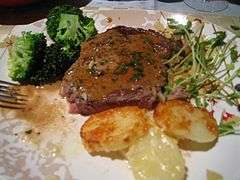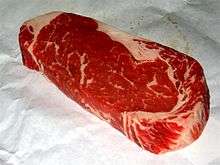Steak Diane
Steak Diane is a dish of a pan-fried beefsteak with a sauce made from the seasoned pan juices, generally prepared in restaurants tableside, and sometimes flambéed. It was probably invented in London or New York in the 1930s. From the 1940s through the 1960s, it was considered a classic of "Continental cuisine",[1][2][3][4] and has since become retro.[5][6][7].
 | |
| Type | Main course |
|---|---|
| Place of origin | United States, United Kingdom, Belgium |
| Created by | Bartolomeo Calderoni (?); Beniamino Schiavon (?) |
| Main ingredients | beefsteak |
History
"Steak Diane" does not appear in the classics of French cuisine, and is first documented in 1940, in Australia. It may have been invented in Belgium, London, or New York.
The name 'Diana', the Roman goddess of the hunt, has been used for various game-related foods,[8] but the "venison steak Diane" attested in 1914, although it is sautéed and flambéed, is sauced and garnished with fruits, unlike later steak Diane recipes,[9] so it is unclear if there is a connection.
In mid-20th-century New York, there was a fad for tableside-flambéed dishes.[10] By the 1940s, steak Diane was a common item on the menus of restaurants popular with New York café society, including the restaurants at the Drake and Sherry-Netherland hotels and The Colony, one of which may have originated it,[11][12] as well as the 21 Club and Le Pavillon.[6][11] It is often attributed to Beniamino Schiavon, 'Nino of the Drake',[4] the maître d'hôtel of the Drake Hotel in New York City, who was said to have created the dish with Luigi Quaglino at the Plage Restaurant in Ostend, Belgium, and named it after a "beauty of the nineteen-twenties"[13] or perhaps "a reigning lady of the European demimonde in the nineteen twenties".[14] At the Drake, it was called "Steak Nino".[15]
The earliest attestation, however, is not in New York, but in Australia. Tony Clerici, maître d'hôtel at the Sydney restaurant Romano's, said he invented it at his Mayfair restaurant Tony's Grill in 1938 and named it in honor of Lady Diana Cooper. It was Romano's signature dish, and was mentioned in a 1940 article about the restaurant.[16][17]
Clerici may have learned the dish from Charles Gallo-Selva, who had previously worked at the Quaglino brothers' restaurant Quaglino's in London,[17][18] which was serving steak cooked tableside in a chafing-dish in 1937.[19] Indeed the head chef of Quaglino's in the 1930s, Bartolomeo Calderoni, claimed in 1988 to have invented Steak Diane.[20][21]
Other stories mention the Café de Paris in 1930's London and the Copacabana Palace Hotel in Rio de Janeiro.[17]
Preparation
Steak Diane is similar to steak au poivre.[22] The steak is cut or pounded thin so that it will cook rapidly. It is seasoned with salt and pepper, quickly sautéed in butter, and set aside. A sauce is prepared from the pan juices with various additions, which may include butter, chives, Worcestershire sauce, mustard, thinly sliced mushrooms, shallots, cream, truffles, meat stock, or A1 Steak Sauce. The sauce is flambéed with brandy, dry sherry, or Madeira, and poured over the steak.
The three New York city recipes from 1953 use few ingredients besides salt, pepper, and butter: brandy, sherry, chives (Sherry-Netherland); chives, dry mustard, lemon juice, Worcestershire sauce (Drake); chives, parsley, Worcestershire sauce (Colony). Only the Sherry-Netherland recipe explicitly calls for flambéing.[12]
See also
- List of steak dishes

References
- Max Jacobson, "Blast from a tasty past", Los Angeles Times, March 26, 1998 : "steak Diane and all the other Continental dishes an up-to-date foodie would be embarrassed to admit knowing of"
- Lobel's Culinary Club, August 17, 2012 : "Steak Diane is among those popular dishes in ubiquitous cosmopolitan, Continental-style restaurants of the 1950s and ’60s that combined high style with leather banquettes, white-linen table cloths and dishes of American and European influences, a bit of theater and dramatic preparation."
- Mark R. Vogel, "Diana: The Legacy of the Huntress", FoodReference : "One thing is for sure. Steak Diane was the rage in the 50s and early 60s, especially in New York."
- Pierre Franey, "60-Minute Gourmet; Steak Diane", New York Times, January 31, 1979
- Florence Fabricant, "New Wave in the East River: David Burke", New York Times November 9, 1988, characterizes it as "retro"
- Leah Koenig, "Lost Foods of New York City: Steak Diane", Politico, March 14, 2012 : "Lost Foods of New York City is a column that celebrates the food and drink that once fed the city, but have disappeared.... America’s collective obsession with all things mid-century New York City is back in full martini-slinging force. What better time, then, to celebrate steak Diane—a dish so quintessentially retro-glamorous, it might as well be called steak Don Draper."
- Jan Aaron, 101 Great Choices: Washington DC, Part 3, p. 76
- Larousse Gastronomique, 1st edition "Oeufs à la Diane", with purée of game; Bécasse (woodcock) à la Diane; etc.; Larousse Gastronomique, 2001 edition, p. 416; Sauce Diane, a sauce poivrade with cream, truffle, and hard-boiled egg white served with venison in Escoffier's Guide Culinaire (1907)
- A.C. Hoff, ed., Steaks, Chops and Fancy Egg Dishes, International Cooking Library, International Publishing Co., 1914, p. 20 full text
- John Fuller, Guéridon and Lamp Cookery: A Complete Guide to Side-table and Flambé Service, 1964, p. 69
- Arthur Schwarts, "'21's Steak Diane", quoting from Arthur Schwartz, New York City Food: An Opinionated History and More Than 100 Legendary Recipes, 2008
- Nickerson, Jane (January 25, 1953). "Steak Worthy of the Name". New York Times Magazine. p. 32. also quoted in Olver, Lynne (2000). "Steak Diane". The Food Timeline.
- "Beniamino Schiavon is Dead; Known as Mr. Nino of the Drake", New York Times, November 19, 1968, p. 47
- Grace Glueck, "Hotel gives fête for its Maître D'", New York Times, October 26, 1967, p. 50
- Stanley Turkel, Great American Hotel Architects, 2019, ISBN 1728306892, p. 311
- "Mayfair", "Heard here and There", Sydney Morning Herald, February 29, 1940, p. 19
- "1939 Steak Diane introduced to Australia", Jan O'Connell, A Timeline of Australian Food: from mutton to MasterChef, 2017, ISBN 1742235344, as quoted on the Australian food history timeline web site
- "Former Host to Royalty Here to Manage Romano's", Daily Advertiser (Wagga Wagga), May 4, 1951, p. 1
- The Atlantic Monthly, 159:274 (1937)
- Caterer & Hotelkeeper 179:53 (1988)
- "Meo is brought to book at last", "The Times Diary/PHS", The Times, April 11, 1978, p. 16
- Mark Bittman, "The Minimalist: A Tender Celebration", New York Times, 8 February 2006 full text
